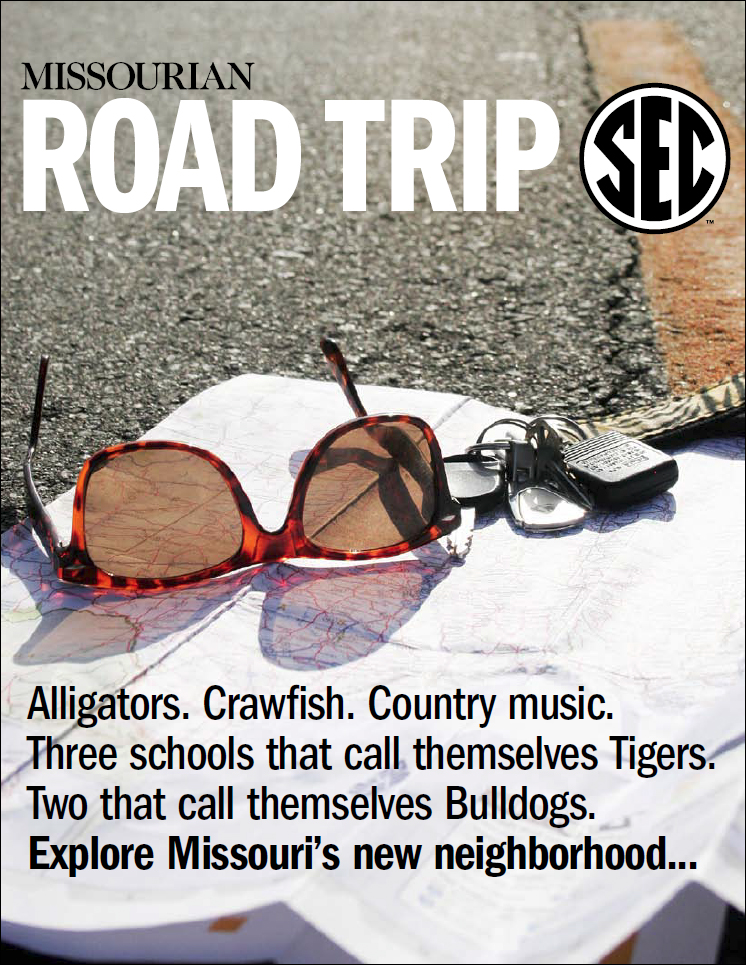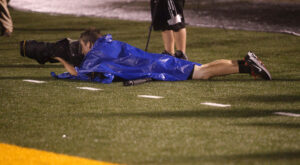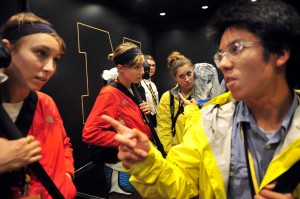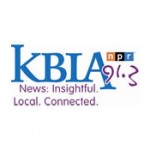Missouri School of Journalism Sports Reporters Cover the Tigers Inaugural SEC Season
New Season. New Conference. New Approach.
By Celia Darrough
Master’s Student
 Columbia, Mo. (Sept. 6, 2012) — Student reporters of the Missouri School of Journalism publications are gearing up to cover the Southeastern Conference this football season.
Columbia, Mo. (Sept. 6, 2012) — Student reporters of the Missouri School of Journalism publications are gearing up to cover the Southeastern Conference this football season.
With the Columbia Missourian, KOMU-TV and KBIA Sports put together, fans can expect to see articles, photos, videos and special features from at least five reporters at away games and even more at home. Stories produced will range from traditional game coverage to features and profiles.
Columbia Missourian
The Columbia Missourian started its coverage during the spring semester, when the newspaper sent reporters to each city within the conference. The goal, sports editor Greg Bowers said, was to get a sense of the local culture and figure out how Columbia compared.
Harry Plumer, BJ ’12, filed some of his last stories for the Missourian when he traveled to Fayetteville, Ark., Columbia, S.C., and Auburn, Ala., in April.
Bowers instructed him to develop a “follow your nose, see what happens” story, so Plumer didn’t do much research before arriving in the SEC towns. Though he initially was so excited that he didn’t feel too nervous about the reporting, Plumer said he had momentary “freak outs” where he questioned if he was doing the right thing.
“It’s very difficult to capture the essence of anything in 24 hours,” Plummer said. “I think, though, that we did as good of a job as we possibly could have done.”
A call from a man who had read his story about Auburn assumed that Plumer was one of the school’s graduates. After praising Plumer for how accurately he captured the spirit of the town, the caller was dismayed to find out that Plumer hadn’t graduated from Auburn.
“I didn’t have the heart to tell him I was only there for one day,” Plumer said. “But when you get calls like that, it definitely makes me feel good about the fact that I can drop into a place and pretty quickly figure out what the deal is, which is an incredibly important skill for a reporter.”

The stories Plumer and other reporters wrote were combined in a special section called “SEC Road Trip,” which published in print and in a downloadable e-book online. Student reporters, photographers and designers worked with Laura Johnston, news editor for the Missourian and production manager for the special section, to gather the content and put it in a publishable format.
The section includes articles on each city in the SEC. The content isn’t all about football: It’s about the culture of the town. An overview of the articles is as follows:
University of Alabama in Tuscaloosa
Tradition of Alabama Football Helps Tuscaloosa Overcome Tornado Tragedy
In April 2011, the most destructive tornado ever to hit Alabama swept through Tuscaloosa, killing 53 people. But the university’s football program has given hope to residents that a normal life, even in the aftermath of a tragedy, is possible. By Andrew Wagaman.
University of Arkansas in Fayetteville
Hills and Hogs Dominate in Fayetteville
Fayetteville might be a Southern town nestled in the Ozarks, but it’s surprisingly close to the great plains of the Southwest. And Razorbacks fandom permeates the entire state. By Harry Plumer.
Auburn University in Alabama
In Auburn, the University and City Form Tight Community
Residents of “The Loveliest Village on the Plains” are as supportive of the university as the students. By Harry Plumer.
University of Florida in Gainesville
Gator Football Common Ground in Diverse Gainesville
Gainesville is a diverse city, both racially and culturally. It’s a mix of Bible Belt, alternative rock, visual artists and fraternity row. Weaving its way through each of those circles – whether they like it or not – is Florida Gator football. By Anthony Schick.
University of Georgia in Athens
Music, Football at the Heart of Athens
Athens residents describe it as a cultural oasis – a high concentration of artists, bands and diverse bars in the middle of rural Georgia. Sometimes its vibrant music scene and the SEC football culture live in harmony, sometimes not. By Anthony Schick.
University of Kentucky in Lexington
Lexington is Horse, Basketball Country
University of Kentucky’s Big Blue Nation keeps Rupp Arena filled. The average attendance of men’s basketball games is the highest in Division I. By Emily Becker.
Louisiana State University in Baton Rouge
At LSU, Everything is Purple
Baton Rouge is a city in a balancing act – caught between the business-driven state capital and the student culture of four universities, one of which happens to be the current SEC football champion. By Emily Becker.
University of Mississippi in Oxford
In Oxford, Weekends Mean Football, Faulkner
A weekend in Oxford, Mississippi, means a combination of football and William Faulkner. By Ben Frederickson.
Mississippi State in Starkville
In Starkville, Boring Is in the Eye of the Beholder
Is Starkville, Miss., the hometown of Mississippi State, really the most boring SEC city? Only if you don’t like shooting rifles out of car windows. By Ben Frederickson.
University of South Carolina in Columbia
Identity of Columbia, S.C., Complicated but Changing
There are still traces of the old South here, but attitudes are shifting and memories are fading. By Harry Plumer.
University of Tennessee in Knoxville
In Knoxville, a Mix of New and Old
Downtown has been the focus of an aggressive redevelopment campaign since 2000, and there has been a significant increase in the number of people visiting downtown in the last 10 years. By Emily Becker.
Texas A&M in College Station
In Aggieland, Traditions Run Deep
Traditions both on and off campus run deep in College Station and neighboring town of Bryan. By Andrew Wagaman.
Vanderbilt University in Memphis, Tenn.
Vanderbilt Teeters Between Southern Charm and Bright Lights of Music City
At Vanderbilt, it’s hard for students to leave the “Vander Bubble” because everything they need is within walking distance. By Katy Bergen.
Behind the Scenes: Cameras Capture Game Action
Those game photos that tell it all – mid-air catches, fumbles, fans’ reactions and more – are produced by a 10-person team of Columbia Missourian photojournalists and photo editors. Two staff photographers are selected to be the lead photographers for the season. Either one of them will lead the other two rotating photographers at home games, and these two photographers divide the away games between the two of them. Hours before kickoff on game day, the crew works to create the pre-game gallery, which includes photos of SEC-style tailgating, fans and other impacts on the city and around the stadium, including Tiger Walk. Readers can find these images on the front of the ColumbiaMissourian.com website in the hours leading up to kickoff.
Getting the photos from the field to the ColumbiaMissourian.com site is almost a sport in itself. To get the first photos on the site quickly, the lead photojournalist has to make several images during the first few minutes of play. The photojournalist hands the memory cards to the photo editor who runs them up to the Missourian’s space in the press box. The photo editor then selects the best photos and sends them to the photo editor in the newsroom. This student writes cutlines and readies the photos for production before sending them to the interactive copy editing desk.
This process repeats itself throughout the game, ensuring that key plays and other highlights are captured and made available to fans in close to real time. Some of the photographs will be selected for the print edition and appear on page 1A, the sports front page, a double-truck of pregame fan photos and one or two photo pages of action.
The urgent experience of covering sports translates easily to any large or breaking-news event whether a photographer is covering a political national convention, the World Series or other stadium-like activities. Organization, file handling and professional equipment are key elements in the Columbia Missourian experience. Communicating across campus or across the SEC only adds to the fun.
Missourian Reporter and Photographer Will Provide Coverage at All Away Games
Missourian readers are assured of having a student sports reporter on the ground at all away games. Most will have to fly to the game given the distance between Columbia and some of the SEC cities. Getting to Columbia, S.C., for example, is a 3-4 hour plane ride versus a more than one-way 14-hour road trip.
Students will arrive before game day and file stories that show the ramp-up to the game. At games, reporters typically arrive an hour or more before opening kickoff. Writers do what Bowers calls “walk-arounds,” where they stroll completely around the stadiums to pick up the flavor and atmosphere.
Throughout the game, reporters will send scoring updates and a short “flash” story as soon as the clock zeroes out. Then, they will write a more complete report and send it to an editor back at the Missourian. Either Bowers, night sports editor Grant Hodder or an assistant editor will read and edit the story before it is sent to the interactive copy editing desk and on to the Web.
Because there are specific SEC social media guidelines that exist to protect broadcasting rights, the Missourian won’t post play-by-plays of the game on Facebook or Twitter.
Outreach Team Will Capture the Game-Day Experience
The Missourian reporter at the game will have some help capturing the game-day experience from fans who travel to the games or alumni who live in SEC towns.
The community outreach team at the Missourian has plans to cover more than the actual game, director of community outreach Joy Mayer said. Through social media and the From Readers section, a section of the Missourian devoted to stories written by readers, Mayer said they plan to capture the game-day experience.

The outreach team, which focuses on engaging the community in conversation, will encourage people to document their experience by however they feel fit. That could include sending in a picture of a tailgate set up, photos of what they are wearing, tweets of the atmosphere of the game or any other option. Mayer said she would like to set up correspondents in each city who can help document the atmosphere of the game away from the field – while the reporter concentrates on coverage of the game itself.
The Missourian also will set up a tent and photo booth just south of Stankowski Field on the ROTC lawn on home game days, inviting fans to stop and get their picture taken by Little Joe, the Mizzou cannon.
The newspaper will use social media to invite readers to help write the game-day headline for the print edition, Frank Russell, the Knight visiting editor, said.
There will be five students working with Russell to improve the presentation of Tiger football coverage on the Missourian’s different platforms, including ColumbiaMissourian.com, mobile devices and social media. Student copy editors, assistant news editors and faculty news editors will help with the project as well.
Russell’s students also will collaborate with Mayer’s community outreach team to create a Missourian Tigers Report football page on Facebook for both the dedicated and casual fans.
But no matter what they do, Mayer said, it might be hard to whet the appetites of SEC-crazed fans.
“We can’t quite do enough,” Mayer said.
 KOMU
KOMU
KOMU-TV has a new technology that will give it the ability to “go live” from away SEC games.
The technology is called LiveU, a backpack cellular live unit that allows KOMU to provide coverage over a cellular phone in full broadcast quality from anywhere in the country. Students will carry it like a backpack and set it up on the scene.
Stacey Woelfel, news director for KOMU, said he is excited for students to have this opportunity.
KOMU sports reporters have done some preliminary reporting to prepare for the season. Students went to a few SEC football games and a basketball game last season, which provided them with some background information. They also attended the SEC media days in Birmingham in July. The conference teams and coaches, who provide interviews for members of media organizations, attend those three media days.
For the new football season, as many as four KOMU students, mainly from the advanced sports reporting class, will drive to all of the away games to report.
“There is a high viewer interest in learning more about this conference since it’s new to everyone,” Woelfel said. “It’s great learning potential to get these students on the road.”
Woelfel said there will be a lot more scene setting in the broadcast this year since the cities are new to both reporters and viewers. Since this is Missouri’s first season in the SEC, the crews will help give people an idea of what football is like in the locations the team is visiting for the first time as a conference member, he said. Post-game analysis and stories that focus on standout players and turning points in the game will follow in the days after the game.
He plans to have post-game analysis and focus on standout players and turning points in the game in the days that follow the game.
KOMU reporters who produce video stories also will write stories for the website and post some information on social media platforms, Woelfel said.
KBIA Sports
Students enrolled in the Multimedia Sports Journalism course taught by Assistant Professor Karen Mitchell will provide action game photos as well as write stories that complement coverage being done by other news media. The items will be posted on the KBIA Sports website, although there is a possibility of a story airing on the radio if it presents an interesting or quirky angle.
The students in the class, which takes a multimedia approach to sports coverage such as photos, videos and slideshows, will report at every home football game. Preparation begins on Monday media days, when they gather information, get story ideas and conduct interviews.
There will be two KBIA Sports reporters at each game. A “word” reporter in the press box will write a traditional game coverage story. A visual reporter on the field will take photos or video.
During away game weeks, the class’s goal is to have a feature story. These are usually profiles of players or a coach, but because the class has every medium available, sometimes they have more offbeat stories. One example from last season is a story about the science of hydration.
Mitchell said she realizes that KBIA Sports might not be anyone’s first stop for sports, so they look for stories that take more time to do or that they have more knowledge of, such as stories that have to do with data.
The students are learning how to complement coverage that is already out there, Mitchell said. They will be looking for stories that other news outlets aren’t doing and trying to seize those opportunities for coverage.
“We realize there are lots of news organizations covering sports,” Mitchell said. “We can’t compete, but we can complement.”
Updated: June 10, 2020
